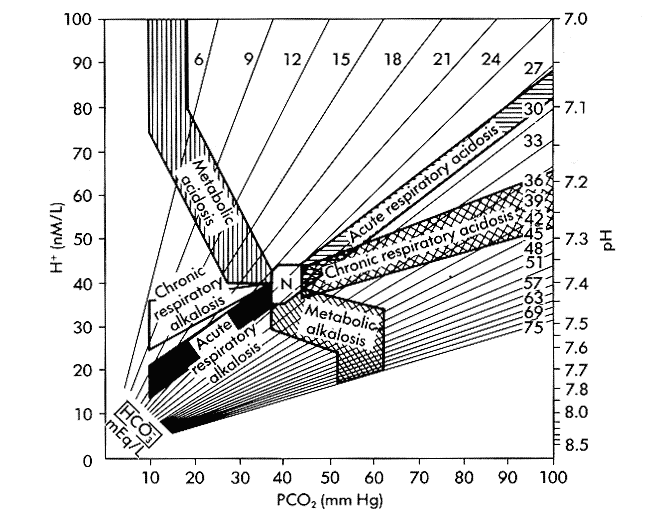
figure adapted from Goldberg, M, Green, SB, Moss, ML et al. 1973 JAMA 223:269


A 19 year old male is brought to a doctor's office in Khandallah by his mother who is very worried. He was found shortly earlier in considerable distress complaining that he was unable to breathe. He is unable to provide a coherent history.
On examination his respiratory rate is markedly increased at rest to nearly 50/min at times. There is no cough. There is no cyanosis (blue tint of lips suggesting a high reduced hemoglobin level) or pallor (reduction in the red colour of the conjunctival mucosa suggesting anemia). He is diaphoretic (sweaty) but afebrile. He is able to speak in short sentences but seems anxious and only answers simple questions. He is making use of accessory respiratory muscles and his breaths are deep with marked chest wall movement. On auscultation of his chest there are prominent air sounds with no adventitiae (added sounds).
* what is a normal adult resting respiratory rate (from your own experience)?
* is this asthma, or an airway problem generally?
* what will be the effect
of increased ventilation on the partial pressure of carbon dioxide in the
arterial blood-an increased level (hypercapnia) or a decreased level (hypocapnia)?

figure adapted from Goldberg, M, Green, SB, Moss, ML et al. 1973 JAMA 223:269
The diagram above is one way of laying out in a plane the three variables
involved in acid-base balance in the blood (PaCO2-the partial pressure of
arterial CO2, HCO3¯-the concentration of the bicarbonate ion, and pH, the
degree of acidity or alkalinity of the blood). The pH can also be expressed
as [H+], the concentration of hydrogen ions (protons). The figure shows
that given any two of these three values the third is determined. Note that
oxygen carriage is not directly related to acid-base status. This 'nomogram'
is used for the interpretation of the results of arterial blood gas tests.
The region labelled 'N' indicates normal acid-base values.
* If there is little change in [HC03¯] so far in this patient, what is the
effect of the change in PaCO2 noted in the last question on the pH of the
blood? What is the category of acid-base disturbance exhibited by this patient?
The patient between gasps says that he has cramping in the arms and tingling
and numbness.
* an increase in blood pH (alkalosis) has some general (systemic) effects
on the body, particularly on the musculoskeletal and nervous systems. Can
you suggest ways in which this might occur?
Instructing the patient to reduce the rate and depth of breathing has no
effect. A feedback loop is occuring, which is maintaining ventilation at
abnormal values.
* a similar feedback loop can maintain disordered function in other systems.
Can you give an example?
* bearing in mind that ventilation is controlled
from the caudal brainstem (medulla oblongata) rather than by the lungs themselves,
can you sketch a figure indicating the course of this circuit?
The young doctor does not recognise the syndrome and sends him off to a hospital.
However, in the ambulance the experienced paramedics resolve his respiratory
distress with a simple manouvre.
* what is the manouvre?
* how does it solve the problem?
* can you suggest
other causes of "hyperventilation" besides the syndrome described here?
The mother quietly informs the doctor that there was a possible precipitating
event involving a break-up with a girlfriend two days before.
* in what proportion of cases does the doctor ever find out what really went on?
Sources of further information:
John Laffey and Brian Kavanagh. Hypocapnia. N Engl J Med. 2002 Jul 4;347(1):43-53.
(local copy here.
Right-click and download or open in a new window.)
Stephen Gluck. Acid-base. Lancet 1998; 352: 47479 (local copy
here). See the last section on respiratory acid-base disorders.